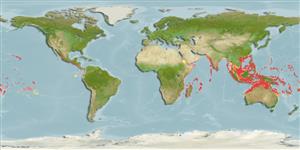Environment: milieu / climate zone / depth range / distribution range
Ecologia
marinhas; Água doce; estuarina demersal; catádromo (Ref. 51243); intervalo de profundidade 0 - 3000 m (Ref. 86942). Tropical; 31°N - 35°S, 21°E - 134°W
Indo-Pacific: East Africa, inland Mozambique and lower Zambezi River to French Polynesia, north to southern Japan (Ref. 7050). Also rivers of Madagascar and adjacent islands (Ref. 52193).
Tamanho / Peso / Idade
Maturity: Lm ? range ? - ? cm
Max length : 70.0 cm TL macho/indeterminado; (Ref. 57749); 200.0 cm TL (female); common length : 26.3 cm TL macho/indeterminado; (Ref. 35840); peso máx. publicado: 20.5 kg (Ref. 13337); peso máx. publicado: 20.5 kg; idade máx. registrada: 40 anos (Ref. 48660)
Vértebras: 100 - 110. Diagnosis: Distinguished from all other species by the mottled colour and the long dorsal fin, which begins closer to the gill opening than to the anus (Ref. 9828).
Live in freshwater areas as adults, estuaries and seas as young (Ref. 12693). Found in lowland rivers as well as upland tributaries (Ref. 2847). While in river, the sex gland does not develop. But in winter when they move from the stream to river mouth, the sex gland begins to develop as mature individuals go to deep sea to breed (Ref. 45563). The spawning grounds are deep sea gullies among the south of the Philippines, east of Indonesia and Papua New Guinea (Ref. 45563). Are active at night, feeding on a wide range of prey (Ref. 7248, 79840), especially crabs, frogs and fish (Ref. 7248). Thought to breed east of Madagascar where the young are wafted to the East Coast by ocean currents (Ref. 13337, 79840).
Ciclo de vida ou comportamento de acasalamento
Maturidade | Reprodução | Desova | Ovos | Fecundidade | Larvas
Castle, P.H.J., 1984. Anguillidae. p. 34-37. In J. Daget, J.-P. Gosse and D.F.E. Thys van den Audenaerde (eds.) Check-list of the freshwater fishes of Africa (CLOFFA). ORSTOM, Paris and MRAC, Tervuren. Vol. 1. (Ref. 3506)
Status na Lista Vermelha da UICN (Ref. 130435: Version 2024-2)
Ameaça para os humanos
Harmless
Uso pelos humanos
Pescarias: espécies comerciais; Aquacultura: espécies comerciais; peixe esportivo: sim
Ferramentas
Relatórios especiais
Baixar XML
Fontes da internet
Estimates based on models
Preferred temperature (Ref.
123201): 15.7 - 27.8, mean 24.5 °C (based on 725 cells).
Índice de diversidade filogenética (Ref.
82804): PD
50 = 0.5000 [Uniqueness, from 0.5 = low to 2.0 = high].
Bayesian length-weight: a=0.00102 (0.00046 - 0.00225), b=3.06 (2.88 - 3.24), in cm total length, based on all LWR estimates for this body shape (Ref.
93245).
Nível Trófico (Ref.
69278): 3.8 ±0.67 se; based on food items.
Generation time: 2.2 ( na - na) years. Estimated as median ln(3)/K based on 1
growth studies.
Resiliência (Ref.
120179): Muito baixo(a), tempo mínimo de duplicação da população maior que 14 anos (tmax=40).
Fishing Vulnerability (Ref.
59153): Moderate vulnerability (42 of 100).
